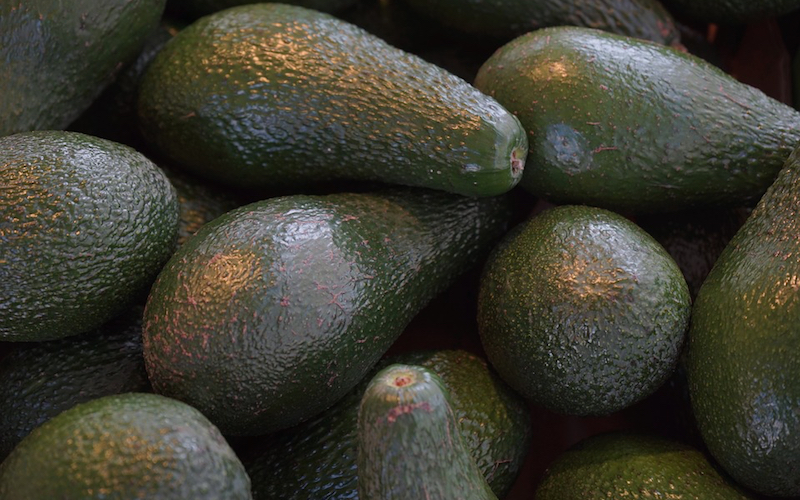
Avocado Demand Fueling Deforestation, Unrest in Mexico
The burgeoning popularity of avocados in the United States has resulted in a global boom in avocado cultivation, as well a number of adverse social and environmental effects in countries where avocados are grown.
In Mexico, the world’s leading avocado producer, the continued expansion of avocado cultivation is contributing to deforestation, unsustainable consumption of water and other resources, habitat destruction for threatened species, and environmental contamination from the use of harmful pesticides and fertilizers. The avocado boom has incentivized illegal logging and cultivation in protected areas, and has provided an alternative revenue source for criminal gangs who extort money from growers, punishing those who refuse to cooperate.
Mexico produced roughly 1.8 million tons of avocados between July 2015 and June 2016, a 7.8 percent increase compared to the previous year, and a nearly 50 percent increase from output levels five years ago. Mexico still consumes a majority – albeit a small one, at approximately 53 percent – of its domestically-grown avocados. If foreign demand continues to grow, Mexico may soon export more avocados than it consumes itself.
The avocado is thought to have originated in Mexico, and evidence of human consumption of avocados dates back to around 8000 B.C.E., with domestication likely occurring around 5000 B.C.E. Until relatively recently, the avocado was a specialty crop with limited consumption. In 1980, the average American consumed less than a pound of avocadoes per year; by 2012, this figure increased to five pounds. Avocado consumption began to take off in the 1990s, aided by a series of successful marketing campaigns, as well as U.S. policy changes that eased agricultural import restrictions.
Most avocados bought and consumed in the United States are Hass avocados – the world’s most widely-grown avocado cultivar, accounting for about four out of every five avocados consumed globally. The Hass Avocado Board, an industry group that promotes and monitoring avocado consumption, publishes weekly summaries of avocado trade volumes in the U.S. So far in 2016, import volumes have averaged around 45 million pounds of avocados per week, fluctuating between 30 and 60 million pounds of avocados. Mexico is consistently the largest exporter of avocados to the U.S., with production levels far exceeding those of other avocado-exporting nations such as Chile, Peru, and the Dominican Republic.
California leads the United States in avocado production, and, despite a persistent water shortage, is on track to produce nearly 400 million pounds of avocados by the end of this year’s growing season (approximately January through September). During the peak of the growing season, California avocado production can match or even exceed the collective volume of avocados imported from Mexico and other countries. However, as demand for avocados continues to grow, California finds itself limited by the seasons, scare water and land resources, as well as price competition from foreign imports. Avocados can be grown in Mexico year-round, thanks to favorable climate conditions. Mexico-to-U.S. avocado trade volumes increase during California’s off-season, peaking during the northern hemisphere’s colder months. The annual cycle of avocado consumption in the U.S. shifts back and forth between avocados grown domestically and those imported from Mexico, with the sum of both volumes continually falling between 30 and 60 million pounds per week. This supply consistency has allowed American consumers to indulge a growing appetite for avocados, a demand fueled by the fruit’s much-touted health properties and popular designation as a “superfood.”
Food trends have the potential to be economically and even socially disruptive for food-exporting nations. The popularity of quinoa helped to improve household income and raise average levels of food consumption for Andean quinoa-producing communities. These positive trends peaked, along with foreign demand for quinoa, in 2014. Since then, Andean quinoa producers have had to contend with falling prices and increased competition from growers abroad. The long-term effects of the quinoa boom remain to be seen, although it now seems unlikely that quinoa growers in Peru and Bolivia will be able to regain the profitability levels that they last enjoyed during the demand peak.
The large-scale ramping-up of avocado production in Mexico will help to sate foreign demand, but is unlikely to provide a source of reliable – let alone sustainable – revenue for producers. In the short term, avocado price fluctuations, variable crop yields, and the continual threat of disease, storms, pests, and other hazards are likely to result in spotty, unstable growth for Mexico’s avocado producers. Despite high and growing demand, the real possibility of “peak avocado” production may well result in lower availability and higher prices for consumers within a matter of years, which could reduce the fruit’s popularity and limit its prevalence in the market.
The avocado boom is limited by economic and environmental constraints, the latter of which includes the specific climate conditions required by avocado trees for optimal production. The Mexican state of Michoacán enjoys a climate that makes it ideal for avocado cultivation. Michoacán produces 88 percent of all avocados grown in Mexico, and is the leading center of global avocado production by a considerable margin. Measurable climate change in Michoacán threatens the future of the state’s agricultural sector, as well as the stability of the global avocado trade.
Unprecedented foreign demand for avocados has incentivized the deforestation of wild areas in Michoacán and other avocado-producing regions in Mexico. Pine and fir tree species are being displaced to make room for avocado plantations, destroying the habitats of endemic species in the process, and fragmenting the natural areas that remain. Deforestation has plagued the Monarch Butterfly Biosphere Reserve, a UNESCO World Heritage site that straddles the border of Michoacán and the neighboring State of México. Over the last decade, logging in the reserve has damaged areas of forest to where Monarch butterflies migrate during the winter months. Environmental stresses faced by the butterfly at both ends of its long migratory route have reduced the species’ population considerably, and a ruling from the U.S. Fish and Wildlife Service regarding the protective status of the Monarch is expected within the next three years.
Avocado trees are a water-intensive crop; to grow a single pound of avocados in Mexico requires 32 gallons of water. 72 gallons of water, on average, are required in the United States, and 97 gallons are required in Chile. Because avocados are grown in regions that are prone to drought, the land allocated for plantations must be planned carefully in order to ensure both the economic viability of avocado production as well as the availability of sufficient water for human consumption and for the irrigation of other crops. Overplanting of avocados can result in undue stress on water resources in areas where such resources are already becoming a precious commodity.
Mexico’s overall economy has already largely shifted away from a disproportionate reliance on agriculture. Economic growth in industrial and service sectors has increased individual economic opportunity and has led to an improved quality of life for most people in Mexico, particularly in more densely populated areas. In rural areas, however, economic opportunism continues to pose a substantial threat to exploitable areas of land and natural resources. Exploitation of the environment translates with troubling ease to exploitation of rural farming communities. In these communities, lawlessness hinders any real state efforts that might hope to curb environmental degradation or to promote long-term environmental or economic sustainability.

